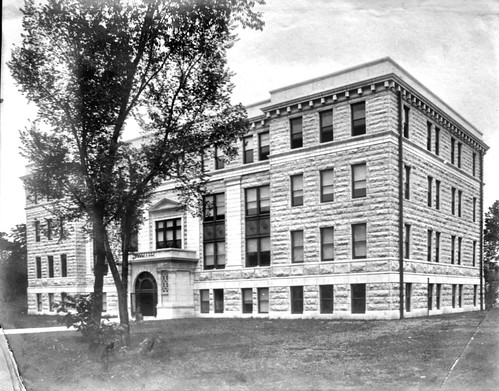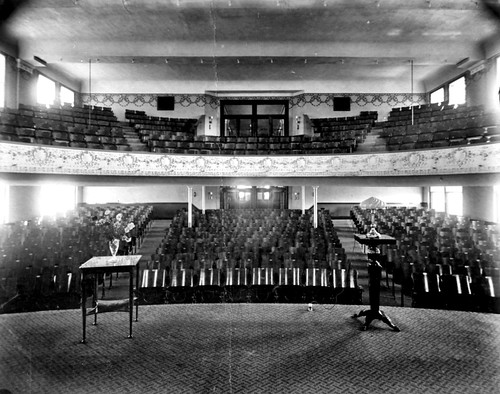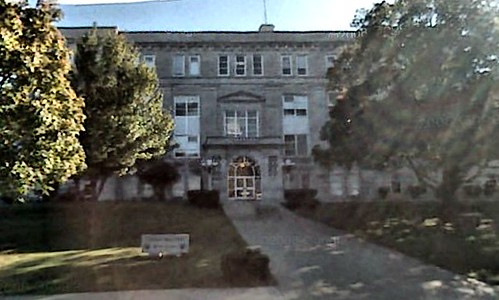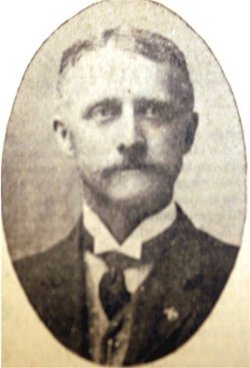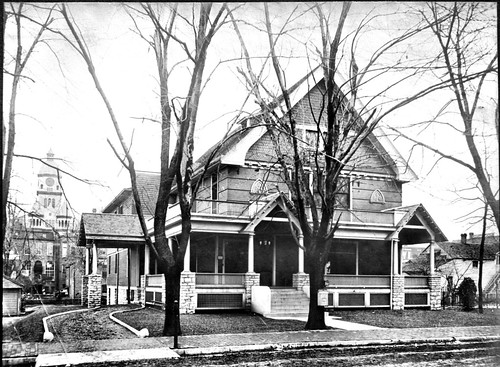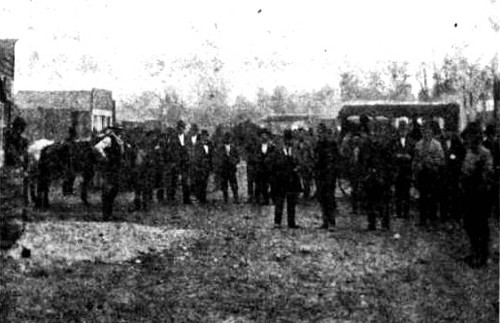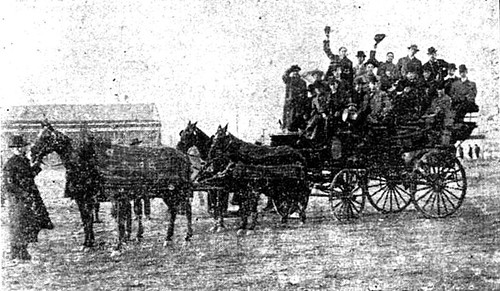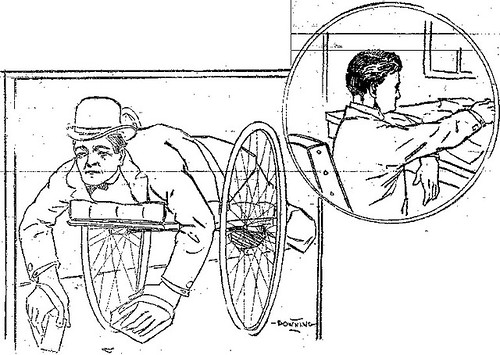In 1904, at a cost of $105,000, Carthage received a new high school to replace its predecessor from 1870. The building received an addition in 1951 and a renovation in 1956. Further additions followed, one as late as 1988. However, the high school transitioned to a junior high school in 2009, when a new high school was built elsewhere. A visit down Main Street Carthage will show the 108 year old building in its current in use condition.
The Architectural Legacy of Garstang & Rea: Earnest B. Jacobs House in Carthage, Missouri
The next photograph in our Alfred W. Rea portfolio series is the Earnest B. Jacobs house in Carthage, Missouri. A History of Jasper County, Missouri and Its People, by Joel T. Livingston, has this to say about Mr. Jacobs:
Life is a voyage, in the progress of which we are perpetually changing our scenes. Ernest Jacobs has now arrived at a port where he can stop a while and look back at that part of the voyage he has already successfully made. He has seen the good and the evil that are in the world,–the ups and the downs, and he has learned to be uncensorious, humane. He has learned to attribute the best motives to every action and to be chary of imputing a sweeping and cruel blame. He has no finger of scorn to point at anything under the sun. Along with this pleasant blandness and charity there is a certain grave, serious humor. From this same port he can see an expanse of waters covered with a mist. If there are rocks ahead he cannot see them; if there are whirlpools he hopes to be able to avoid them with the aid of the same pilot that has guided him heretofore and by steering with the same steady hand that has up to this port kept his course straight.
Launched on the sea of life July 20, 1858, in the port of Chicago, Illinois, Ernest B. Jacobs set sail. To leave metaphor for a while, his father, John W. Jacobs was born in New York state in Watertown. He was educated there and studied for the ministry. He entered the Methodist church, his first charge being in his native state. Then he was stationed in Chicago, Illinois, where he was very well known on account of his eloquent oratory and his earnest, conscientious work. While he was still living in New York he married Lucy Young, a native of Ohio. After the death of her husband in Kansas City she went back to New York, where she is living with one of her children.
Ernest B. Jacobs went with his parents from Chicago to Carthage when he was very young. He went to the public and high schools in Carthage. Upon leaving school he taught for a number of years. Although he was a successful teacher, he did not intend to make teaching his life work. In 1877 he was tendered the position of assistant postmaster in Carthage; he accepted the office and held it for eight years, at the end of which time he became associated with the First National Bank of Carthage.
Desiring to learn the banking business thoroughly in all its branches, he started in at the bottom of the ladder, but quickly mounted the rungs until he became cashier. He has held this position for a number of years and is considered one of the veteran financiers of Carthage. During the twenty-six years of his connection with the First National Bank there have been a number of panics, but in that period the bank has never been obliged to borrow a dollar, nor has it been in financial straits at all. He is a director of the banks at Alba, Reeds and LaRussell and it is a significant fact that all three banks have been in a flourishing condition since his connection with them.
In 1884 Ernest B. Jacobs drifted into the matrimonial sea, taking with him Miss Carrie Farwell, belonging to an old Carthage family. The course was steered clear of the breakers which impede the progress of so many sailors in the same sea. They have two children Ernestine, born in Carthage, January 3, 1895, has just (1911) completed her course at the Carthage high school. Jay W. Jacobs, born in Carthage January 7, 1899, is attending the grammar school.
Mr. Jacobs’ connection with the Masons has been a very pleasant one. He is a member of the Carthage Blue Lodge, a Royal Arch Mason, a Knight Templar and a Shriner. He is a member of the Elks Club at Carthage. He is a Republican and by reason of his position and his wide circle of acquaintances is very influential in the political world. Brought up in the Methodist faith, he has continued with the same beliefs. He encourages his wife in her desire for continual self culture and most heartily approves of the literary club of which she is a prominent member. Mr. Jacobs believes that everybody must work and may play; he throws as much enthusiasm into the one as into the other.He is an ardent and successful sportsman. He is a member of the Carter County Hunting & Fishing Club, of the Miami, Oklahoma Hunting & Fishing Club and of the Vernon County Field Club. When he takes a vacation he generally employs it in the indulgence of one or the other of his favorite pastimes, hunting or fishing. Whether in business, the world of sports or private life Mr. Jacobs is very popular and has the confidence of all who know him.
On December 12, 1927, the widowed Earnest Jacobs passed away from a stroke. Upon his death, Knell Mortuary oversaw funeral arrangements. Five years later, in 1932, Knell Mortuary purchased the Jacobs House and has since remained at the corner of West Chestnut and Garrison Avenues.
Architectural Legacy of Garstang & Rea: Elks’ Clubhouse in Carthage, Missouri
Our next photograph in the Alfred W. Rea portfolio series is the Benevolent and Protective Order of Elks clubhouse in Carthage, Missouri. The clubhouse was built in 1901 at an expense of $8,500, or approximately $220,000 in 2010 dollars. The Carthage Lodge No. 529 was founded sometime before 1900 and became defunct sometime before 1947. Presumably, the clubhouse was torn down at some point.
A Joplin Football Outing
By the 1890’s, both Joplin and Carthage had been bit by the football bug. Naturally, the two engaged in an intercity rivalry with teams from one traveling to play the other. In the above, the Joplin team has engaged a “four horse tallyho” to carry them to the proverbial battle ground, a field located on the east side of Main Street between Sixteenth and Seventeenth Streets. It was known as the Joplin Bicycle Track. It’s unknown if the local boys won the match, but we’ll just assume so. After all, their opponents WERE from CARTHAGE.
Source: Joplin Daily Globe.
Carthage Christmas Homes Tour
For those of you who missed the announcement in last Sunday’s Globe, it was announced that the Carthage Historic Preservation, Inc., will be running a historic home tour next month (click on the link for descriptions of the featured homes). The tour will run from 10 am to 4pm on December 4th for a price of $20 at the door, but buying a ticket in advance will save you $5. A tea will also be available for $6, and Christmas/Winter themed paintings by regional artists will be available for purchase. It’s a great chance to enjoy history quite literally from the inside out. For those of you who love turn of the century homes and just don’t get the chance to visit them often enough, next Saturday will be an opportunity not to be missed.
Carthage Points Out Joplin’s Wrongs
In years past, Carthage and Joplin have had an unspoken rivalry. Sometimes this rivalry would manifest itself in spirited jibes published in the papers, but more often than not it was the Carthage Evening Press that took swipes at Joplin, rather than the Globe or News-Herald that tried to besmirch Carthage’s reputation. The following article is one of hundreds of news items that the Evening Press ran over the years about incompetent, lawless, wicked Joplin.
“Lawless at Joplin. Many Robberies Occur Between the two towns — Police Protection Needed.
‘Kid’ Holden, who runs a gambling device in the Barbee building [Note to Readers: House of Lords] and lives on the corner of north Mineral and Hill streets, East Joplin, was robbed on Broadway, between East and West Joplin, Saturday night, while on his way home. The robbers were secreted behind the bill-boards on Broadway, between Virginia and Pennsylvania avenues, and as Holden approached he was clubbed into unconsciousness — the robbers taking a gold watch and pocketbook which contained $7. It is reliably reported that an attempt was made to ‘hold-up’ Holden some time ago, but he ran his assailants away with a revolver.
This audacious robbery has occasioned much talk in East Joplin, and has brought out the fact that there have been upward of a dozen attempts at ‘hold-up’ and robbery between the two towns within the past two or three weeks. A citizen of East Joplin says: ‘Crooks are to be seen almost nightly between Main street, on the west side and the bridge and its vicinity on the east side, where they are either skulking about the lumberyard, railway crossing, hiding about freight cars, the dives or shanties in the vicinity, or the bill boards.
‘Not long since,’ he continued, ‘an east town lady, while purchasing groceries on the west side, displayed a rather full pocket book in her rounds, she had not gone far on her way home before a robber approached her. But just then a car came gliding down the hill. She at once ran toward it, and the thief made a hurried break in the opposite direction, and was almost instantly out of sight.’
‘It would be a very easy job to ‘pull’ these ‘crooks’ and break up the robbers roost between the two towns, but no attempt has yet been made to afford any relief whatever. The crooks are actually safer between the two towns than any other part of the city.[Editor’s Note: The area between the two towns probably refers to the area known as the Kansas City Bottoms.] The police, or its chief, evidently consider it the duty of the force to remain about the crowded streets, and protect the saloons, and ‘pull’ those who patronize those institutions ‘too freely,’ and thus swell the city’s funds while leaving the various outlying thoroughfares of the city of Joplin utterly unprotected.’
‘It is claimed that if three picked men were taken off the police force, the remainder would not be worth a snap of the fingers. The force is the most incompetent in the history of the city. The recent east town shooting affair — when two policemen in attempting the arrest of an unarmed crippled boy over a twenty-five cent game of cards in a saloon, shot him down at close range — is an illustration.”
Source: Carthage Evening Press
Globe Coverage of Powers Museum Lee Grant Exhibit
We previously mentioned the impending opening of the traveling Lee – Grant Exhibit, but wanted to bring to attention some coverage of it by the Joplin Globe. The article includes a nice list of events happening in relation to the exhibit such as lectures, and reminds us, the exhibit is only around until the 20th of this month! Also touched upon is Amanda Shurlds, the wife of General Grant’s brother-in-law. With the impending 150th anniversary of the Civil War about to begin next year, now is the time to refresh yourself with the generals who helped brought about the war’s end.
Carthage Attorney Charles Wild: Defying the Odds
Although he was a citizen of Carthage, Charles Wild’s story is worth mentioning on Historic Joplin. As a young boy growing up in Sarcoxie, Wild suffered a bout of scarlet fever. He was left crippled and unable to walk. Wild, however, was undeterred.
Although he could not play baseball or swim in a country stream, Charles Wild focused on his studies. It was said that as a mere boy he took over as the bookkeeper and business assistant in his father’s nursery in Sarcoxie. Later, when he was older, Charles attended St. Louis Law School (now called St. Louis University). After graduation he opened a successful law practice in St. Louis before he returned to Sarcoxie in 1906 and became the law partner of H.T. Harrison of Carthage.
What made Charles Wild unique was that although he was unable to walk, he still managed to travel all over town with the aid of a cart that was described as a, “small box-like affair hung between two large rubber-tired wheels resembling those of a bicycle. The box of the cart is just large enough to admit his body and in this, when he desires to move around, he is strapped. Then, leaning forward, he propels himself by pulling himself along with his hands. He carries wooden blocks which he uses to preserve his hands.”
Wild could travel faster than the average pedestrian unless there was snow on the ground when “it is almost impossible for him to make any progress.” In addition, “rough roads and in wet and muddy weather” were a hindrance.
Despite his physical challenges, he was an accomplished author and attorney, with some of his work published in contemporary publications such as Harper’s and Century Magazine. He was noted as “an advocate of great ability before a jury. His physical condition is no handicap to his prowess as a speaker.” Wild would often ask to be taken from his cart and seated in a chair, “his head barely showing above the edge of the table” when he delivered “some of the most highly polished arguments and addresses ever hard in a tribunal of justice in this county.”
Wild, it was noted, “was respected by everyone, a friend to whom one can go in time of need, he is not only one of the most able but one of the most beloved men in Carthage.” He depended “upon his own abilities for making his way in the world” and he certainly did.
Source: Joplin Globe
